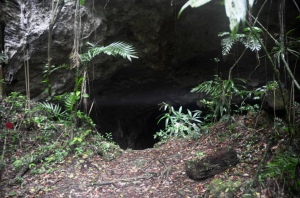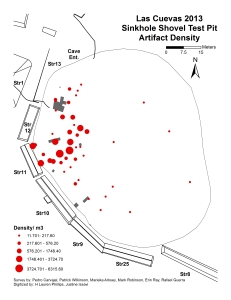by Dorie Perez
In the Maya tradition, caves were believed to be the entrance to the underworld, where people could make offerings to gods for rain, better harvests and health. Building on advancements in archeological scholarship on the Maya that had archeologists shifting focus away from large-scale built monuments to smaller areas of ritual practice in the 1990s, Marieka Arksey, a 2014-2015 Center for the Humanities Graduate Fellow, centered her study on three years’ worth of empirical fieldwork in the jungles of Belize. A fourth-year doctoral student in the World Cultures graduate group, she has focused on the ritual practices of the Terminal Classic Maya outside of the entrances of caves as a way of creating a more naturalized sacred site than the monumental temple structures being erected in the same time period.
Mouth of cave site at Las Cuervas, Belize where Arksey did her work (2014).
The built environments of large-scale civic centers were translated to the spaces outside of caves as exceptionally potent places for communion with the forces that were thought to give life to ancient Maya societies. Arksey’s study shows that the discovery of man-made modifications to the areas directly outside of caves made them look more ordered and utilitarian. These modifications were created to look natural and occurring spontaneously, as though stemming from the cave itself, making clear the importance of the naturalistic aesthetics of the cave even as they are reformed through human interaction. Using fragments of ceramics, obsidian, chert, quartz, jute, and speleothems to show that ancient rituals did indeed occur here, and type-variety analysis of the ceramics to place the age of modifications to the Terminal Late Classic period (between 700 and 950 CE), she is able to make an argument that these spaces have been created specifically for an extension of the rituals taking place inside the caves.
Map of archeological sites in Arksey’s doctoral research (2014).
Arksey argues that the ‘collapse’ of the Terminal Classic Maya in the Southern Lowlands likely involved a loss of faith in the ruling elite and led to the adaptation of rituals in and around caves to offset that loss of faith. If rituals taking place within caves were failing to provide sought after results, elites would begin to use open spaces outside of caves for the first time in order to allow for much more public observation. This adaptation of ritual may have allowed them to better appease their followers. Arksey showcased visual evidence of modern rituals still occurring outside some sites by modern Maya in Belize, reinforcing her argument that these sites are still recognized as cosmologically and historically significant and adding to the literature on the Maya response to cultural disruption.
Arkesy’s presentation touched on interdisciplinary questions about cultural conception, the use of physical space and the significance of such academic work in relation to the history of the field of archeology itself. Sholeh Quinn, Associate Professor of Iranian History, added a layer of nuance in her role as discussant – the cultural output of the Maya and the significance of the work on cave rituals understudied in that area of Central America was emphasized as an important point of analysis that furthers the understanding of ancient cultures as systematized human reaction to a changing world.


